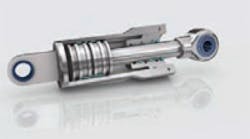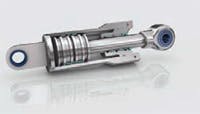Polytetrafluoroethylene (PTFE) has some great properties as a material for seals. It exhibits very low friction against most materials, is unaffected by most chemical solutions, and tolerates an extremely wide range of temperatures. However, its soft consistency makes it susceptible to wear, deformation, and it has low extrusion resistance in comparison to filled PTFE materials.
However, Trelleborg Sealing Solutions, Fort Wayne, Ind., has developed a PTFE-based sealing material that stands up to such key hydraulic sealing characteristics as friction, wear, and high pressure. Testing has also shown that Trelleborg’s Turcon M12 is compatible with virtually all media. Furthermore, the material offers long seal life, a low cost-to-performance ratio, and a wide operating window for temperature, pressure, and velocity.
“Turcon M12 has exceeded expectations, and, in our opinion, no other material can give such universally exceptional performance,” says Nancy Getz, product manager for Trelleborg. “On almost every parameter it is better than previously recommended compounds — sometimes very significantly — or was at least equal to them. Turcon M12 can fit virtually all hydraulic applications and meet a more universal range of applications.”
Turcon is the Trelleborg Sealing Solutions brand of proprietary PTFE sealing materials. More specifically, Turcon M12 matrix is mediumfilled with a complex mix of nonabrasive mineral fibers combined with additives. It was developed by Trelleborg Sealing Solutions, Helsingr, Denmark, and tested in R&D labs in Stuttgart, Germany, and Fort Wayne.
Before its launch, Turcon M12 underwent extensive testing to compare it to best-in-class compounds for important sealing characteristics within hydraulic applications.
Performance at different pressures and speeds
- Lowest friction force at all pressures and velocities.
- After the run-in period, friction lower than for all other compounds tested.
- Combined lowest wear and deformation, leading to extended seal life.
Mineral oil compatibility
- Matched best-in-class materials.
- Lowest friction force of all compounds tested.
- Smallest reduction in seal profile height, giving lowest overall wear and deformation.
Environmentally-friendly hydraulic fluid compatibility
- Outstanding leakage control.
- Friction force extremely good with excellent stability.
- Reduction in radial height of the profile comparative with best-in-class materials.
Wear test — wind turbine pitch cylinder specification
- Only slight polishing of chromeplated rod with no micro-scratching and no extrusion.
- Roughness values remained constant, enabling the tribological system between seal contact area and counter surface to run in a defined area.
- Seal surface showed virtually no wear.
High-pressure wear test
- Seals showed virtually zero wear with no micro-scratching.
- Performed better than any other compound within same family.
Wear test — short stroke, high frequency
- Prevents counter surface scratching.
- Grinding pattern still visible on the rod even after 1.3 million cycles.
- Only slight polishing of the metal surface and no micro-scratching.
- Particularly suited to applications with short-stroke, high-frequency movements.
Click here to watch a video describing Trelleborg's Turcon M12 material or click here to download a descriptive PDF file.


